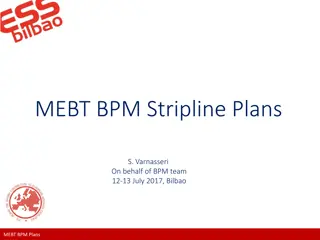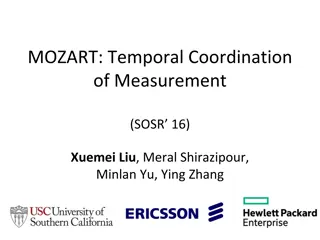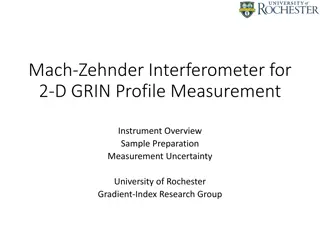Understanding Business Performance Measurement (BPM) and Essential Elements
Business Performance Measurement (BPM) refers to the processes used by organizations to assess their performance and achieve set goals. It involves employing tools, techniques, methodologies, and metrics to monitor and manage business performance. Performance measures help evaluate progress, goal achievement, customer satisfaction, process control, and areas for improvement. Essential elements of performance measures include objectives, typical measurements, and criteria that focus on improving processes, comparing performance with goals, and providing valuable information for evaluation and decision-making.
- Business Performance Measurement
- BPM
- Performance Measures
- Organizational Management
- Performance Evaluation
Download Presentation

Please find below an Image/Link to download the presentation.
The content on the website is provided AS IS for your information and personal use only. It may not be sold, licensed, or shared on other websites without obtaining consent from the author. Download presentation by click this link. If you encounter any issues during the download, it is possible that the publisher has removed the file from their server.
E N D
Presentation Transcript
UNIT-3 BUSINESS PERFORMANCE MEASUREMENT (BPM) By: Prof. K.V. PAVAN KUMAR, Methodist College of Engg & Tech., Abids, Hyd.
1. BUSINESS PERFORMANCE MEASUREMENT (BPM) - DEFINITION: Business performance measurement (BPM) refers to the management and analytical process employed by the management of an organization to assess the performance of the organization to achieve the goals pre- defined by the management of the organization.
BPM may be defined as different business tools, techniques, methodologies and metrics employed by an organization to measure, monitor and manage the performance of the business enterprise .
PERFORMANCE MEASURES LET USKNOW: 1 how well we aredoing 2 if we are meeting ourgoals 3 if our customers aresatisfied if our processes are in statistical control 4 if and where improvementsare necessary. 5
ESSENTIAL ELEMENTS OF PERFORMANCE MEASURES (BY RAY F . BOEDECKER) 1.Objectives 2.Typical measurement 3.Criteria 4. Characteristics
1. Objectives - Performance measurements as used to achieve one or more of the following six objectives: a. Establish baseline measures and reveal trends b. Determine which processes need to be improved c. Indicate process gains andlosses d. Compare goals with actual performance e. provide information for individual and team evaluation f. Manage by fact rather than gutfelling
2. Typical Measurement - What should be measured is frequently asked by managers and teams. a. Human resources b. Customers c. Production d. Researchdevelopment e. Suppliers f. Marketing/Sales g. Administration
3. Criteria - All business organizations have some measurements in place that can be adopted for TQM. In order to evaluate the existing measures or add new ones, there are seven criteria to befollowed: a. Simple b. Few in number
c. Developed by users d. Relevance to customer e. Improvement f. Cost g. Visible
4. Characteristics - One of the seven basic characteristics is used to measure the performance of a particular process or function. a. Quantity most common measures; refers to how many units a production or business produces b. Cost amount of resources required to produce a givenoutput c.Time
d. Accuracy number of non-conformancesin the output e.Function f. Aesthetics how the product looks, feels, sounds, tastes, or smells and is quite subjective g. Service serviceactivity
WHY DO WE NEED TOMEASURE? Control: -Measurements help to reducevariation Self-Assessment: -Measurements can be used to assess how well a process is doing, including improvements that have beenmade ContinuousImprovement: -Measurements can be used to identify defect sources, process trends, and defect prevention, and to determine process efficiency and effectiveness, as well as opportunities for improvement ManagementAssessment: -Without measurements there is no way to be certain we are meeting value-added objectives or that weare being effective and efficient
2. BPM VS BI: Key differences of BPM and BI: 1) Meaning: A)BPM: BPM refers to the different tools, methods and metrics employed by an organization to measure, monitor and management business Performance. B) BI: BI refers to the art and science of analyzing any data or information, with a specific business Objective.
KEY DIFFERENCES OF BPM AND BI: 2) SCOPE: BPM: The Scope of BPM is wider. BI: The Scope of BI is comparatively narrower.
KEY DIFFERENCES OF BPM AND BI: 3) TOOLS USED: BPM: BPM employs multiple tools, methods and metrics, which includes all the BI tools as well. BI: BI employs a wide variety of tools and techniques such as OLP adhoc querying, dashboards, scorecards etc.
KEY DIFFERENCES OF BPM AND BI: 4) PROCESS INVOLVED: BPM: BPM involves multiple processes including BI+, Planning, cycle of plan, monitoring and analyzing of Business Performance. BI: BI processes are limited only upto analyzing of Business Data.
KEY DIFFERENCES OF BPM AND BI: 5) NATURE: BPM: BPM is highly flexible in nature and is actively integrated with the ongoing organizational projects. BI: BI is static in nature. Its primary focus is upon measuring the performance of already completed business projects.
3. SUMMARY OF BPM PROCESS : Business performance measurement (BPM) refers to the management and analytical process employed by the management of an organization to assess the performance of the organization to achieve the goals pre- defined by the management of the organization.
Business performance management is also known as corporate performance management or enterprise performance management.
SUMMARY OF BUSINESS PERFORMANCE MANAGEMENT PROCESS: A) BMP is a set of integrated, closed-loop management and analytic processes, supported by technology, that address financial as well as operational activities. B) BPM is an enabler for businesses in defining strategic goals, and then measuring and managing performance against those goals.
KEY DIFFERENCES OF BPM AND BI: C) Core BPM processes include:- Financial and operational planning, consolidation and reporting, modeling, analysis and monitoring of key performance indicators (KPIs) linked to organizational strategy.
4. PERFORMANCE MEASUREMENT: Performance measurement is the process of collecting, analyzing and/or reporting information regarding the performance of an individual, group, organization, system or component.
Performance refers to output results and their outcomes obtained from processes, products, and services that permit evaluation and comparison relative to goals, standards, past results, and other organizations. Performance can be expressed in non-financial and financial terms.
Measurement refers to numerical information that quantifies input, output, and performance dimensions of processes, products, services, and the overall organization (outcomes). Performance measures might be simple (derived from one measurement) or composite.
There are a number of challenges that are faced when designing an effective Performance Measurement System, these include the following: How to measure non-financial performance What measures to choose and why
How to use them - what to do with the results Who should be responsible for using the results How and to whom, to communicate the results The resources needed to consider the above and design and deploy the measurement system
PERFORMANCE MEASUREMENTS FOR THE NEW ERA In the global, technology-driven, decentralized environment, measuring Financial performance, while important, is not adequate. Even if less than precise, other measures of performance are required. These measures should be capable of measuring multiple attributes of an organization.
We need a balanced set of Performance Measures We need both lead and lag indicators
LEAD INDICATORS AS VALUE DRIVERS Many non-financial indicators can serve as lead indicators in certain settings. Common examples are: Market share, new product introductions, new product development lead times, product quality, customer satisfaction, employee morale, personnel development, inventory turnover, bad debt ratio, or safety
LAG INDICATORS In contrast to lead indicators, lag indicators are measures that point to earlier plans and their execution. Financial performances are lag indicators. Many times, financial performances are too late to affect future products and services. Therefore, we need multiple measures that include both financial and non- financial measures.
COMPREHENSIVE PERFORMANCE MEASURES MUST ADDRESS 1. Financial performance 2. Customer satisfaction 3. Internal business process developments and 4. Allow an organization to learn and grow.
FINANCIAL PERFORMANCE CAN BE MEASURED BY ROI, ROA, ROE, EPS etc. These measure are essential to summarize the economic consequences of any company s strategy.
CUSTOMER-RELATED MEASURES Managers must identify the customer and market segments in which the business desires to compete. Develop measures to track the business unit s ability to create satisfied and loyal customers.
CUSTOMER-BASED MEASURES Customer Satisfaction Customer Retention Customer Loyalty Product and Service Attributes Image and Reputation
INTERNAL BUSINESS PROCESS (IBP) MEASURES: Identify the critical internal processes for which the organization must excel in implementing its strategy. IBP dimension enable the business unit to: Deliver the value propositions that will attract and retain customers in targeted market segments, and Satisfy shareholder expectations regarding financial returns.
INTERNAL BUSINESS PROCESS MEASURES Operation Processes Innovation processes Quality Measures Cycle Time Measures Cost Measures
LEARNING AND GROWTH MEASURES Learning and growth identifies the infrastructure an organization must create long-term growth and improvement. Growth comes from: people, systems and organizational procedures. build to
A performance concept that combines everything that we discusses so far is: Six Sigma
THE SIX SIGMA Is a business process that enables companies to increase profits dramatically by streamlining operations, improving quality, and eliminating defects or mistakes in everything a company does. The objective is change the process so that defects are never produced in the first place.
THE OBJECTIVES OF SIX SIGMA To Satisfy the Customer by changing internal performance and processes. To enable better performance by better design To Improve the Quality of Supplies and other Operational Processes . Manage the costs
SIX SIGMA POINTS OUT You don't know what you don't know -- You can't do what you don't know.. You don't know until you measure.. You don't measure what you don't value.. You don't value what you don't measure..
5. BPM METHODOLOGIES: Methodology Element: Specific Procedures or techniques 1) Management: List of all core and support processes; list and definitions of leadership and team roles and responsibilities . 2) Process improvement with phases Definition of phases; examples of required and optional work products in charter, discovery, analysis and redesign phases
3) Measurement Data elements for before and after; analytical data elements; customer data, competitive data, and ongoing monitoring data. Decisions from data. 4) Learning Skills needed for BPM techniques; delivery of training and real time learning; learning for BPM leadership, project and team roles
5)Alignment with Organizational Priorities: Techniques to prioritize processes such as strategic plan, Enterprise architecture, 3 x 3 box performance criteria etc. 6) Continuous Improvement: Roles, monitoring frequency, monitoring methods and signals
7)Technology: Standard technologies used across the enterprise. Where are custom technologies used and why? 8)BPM Common Practices Agreed internal common practices, such as roles, analysis techniques, group, assessment
6. BPM ARCHITECTURE AND APPLICATIONS: BPM ARCHITECTURE: BPM architecture is intended to ensure that a company automates its business processes. It can be said that BPM architecture is a general definition of an entire system of processes. The intended use of good BPM architecture is to improve processes and hence optimize results.























